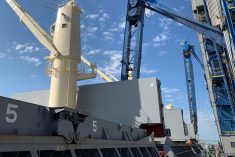Having shut its locks for the season on New Year’s Day, the operators of Canada’s St. Lawrence Seaway system report moving a “blowout volume” of grain during the 280-day 2014 shipping year.
The St. Lawrence Seaway Management Corp. (SLSMC) on Monday reported having moved a total cargo volume of 40 million tonnes during the season, which it said marks a “full recovery” from the fallout of the 2009 worldwide financial crisis.
The total cargo handle was a seven per cent increase from the seaway’s 2013 traffic, the corporation said.
Read Also

U.S. grains: Soybeans touch 16-month high, wheat firm on Chinese demand hopes
Chicago soybean futures hit 16-month highs on Monday on expectations China will restart large-scale U.S. soy buying after the two countries reached a deal to de-escalate their trade war.
The seaway — which opened March 28, about a week later than usual due to cold conditions and heavy ice in the spring — closed New Year’s Day after an eastbound vessel, the Sten Bergen, passed through the St. Lambert Lock at Montreal shortly after midnight.
During that 280-day stretch, “carriers moved over 12 million tonnes of grain through our locks, the highest volume since the turn of the century some 14 years ago,” SLSMC CEO Terence Bowles said in a release.
Specifically, the seaway reported moving 12.073 million tonnes of grain in 2014, a 44.2 per cent increase from its 8.374 million-tonne grain handle in 2013.
Given that farmers and grain merchants were “furiously” seeking avenues to move the 2013 bumper crop, which in part led to clogged Prairie rail lines and a massive grain backlog, “there can be little question that the seaway proved its value as a vital transportation artery in 2014,” he said.
Iron, steel, salt
The grain traffic was the main driver behind the increased traffic, along with “strong” volumes of iron and steel products, the corporation said.
Shipments of road salt, needed to replenish inventories that were “severely depleted” during the winter of 2013, were also cited as a driver of added traffic.
In all, the seaway saw 3,909 vessel transits during the shipping year, up from 3,900 during 2013.
During 2014, the corporation noted, three more locks were commissioned with “hands free” mooring equipment, for a total of four locks with vacuum pads as a means of mooring ships.
By the end of 2017, all seaway high-lift locks will be equipped with automated mooring equipment, the company said, which will eliminate the need to manually tie up vessels using lines.
Seaway carriers in 2014 also continued to modernize operations by bringing in new state-of-the art vessels, “purpose-built” for use on the seaway and allowing for “sharp increases” in fuel efficiency, the corporation said. — AGCanada.com Network











